100th Anniversary Great Nave Tour at the Cathedral of St. John the Divine
Celebrate the 1925 construction of the stunning nave inside the world's largest Gothic cathedral!


On the road to Lake Placid, New York you’ll start to see historical signs making where the pre-Civil War abolitionist John Brown had some connection to. In the history books, Brown is most associated with the armed raid on the U.S. Arsenal at Harper’s Ferry, Virginia in 1859, for which he was convicted as a traitor and hung, but a visit to his final burial place and farm in Lake Placid provides more context to the man. As a sign states at the John Brown Farm State Historic Site, “although he was convicted as a traitor, many considered Brown a martyr in the fight for freedom.” The story of John Brown also includes so many on both sides of the struggle to abolish slavery, including Harriet Tubman, Frederick Douglass, Robert E. Lee, Stonewall Jackson, John Wilkes Booth, and even Victor Hugo.
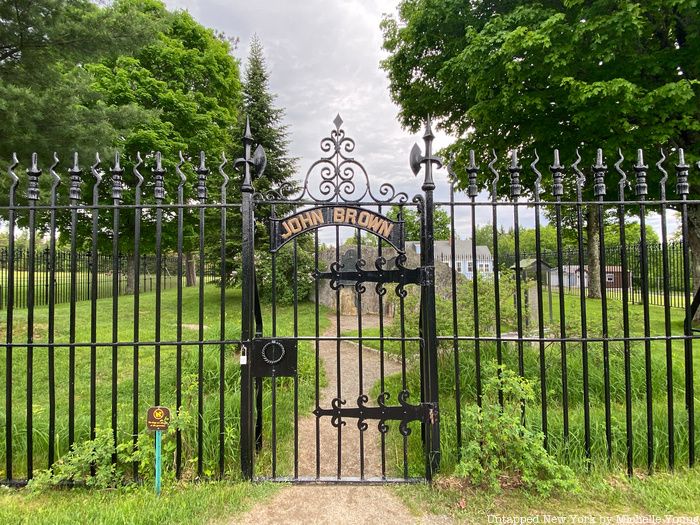
Brown was born in 1800 in Connecticut to a religious family and his parents were active in the Underground Railroad. He had originally sought to become a minister but for financial reasons went into the tannery business, running farms in Pennsylvania, Ohio, Massachusetts, and finally in North Elba, New York near Lake Placid. Throughout these moves, which saw both heartache with the death of his first wife and many of his children, along with financial ruin, he operated safe houses for the Underground Railroad and continued to write and speak about abolition. He is mentioned in the writings of Frederick Douglass, who met Brown in Springfield, Massachusetts in 1844: “From this night spent with John Brown in Springfield, Mass. 1847 while I continued to write and speak against slavery, I became all the same less hopeful for its peaceful abolition. My utterances became more and more tinged by the color of this man’s strong impressions.”
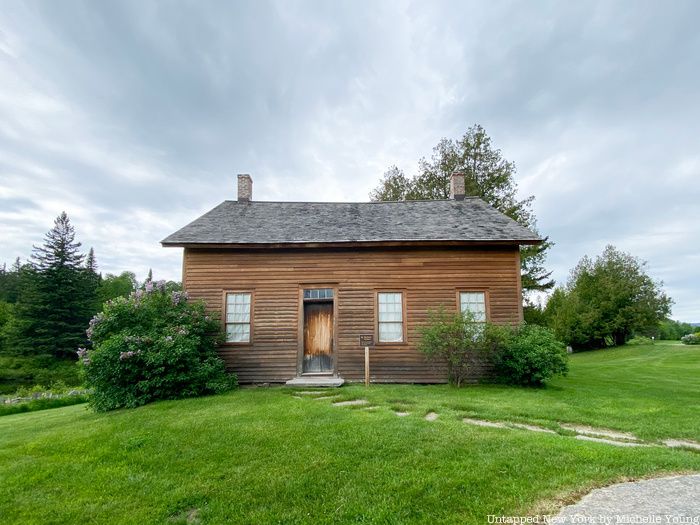
The Brown family, with Brown’s second wife Mary Ann Day who bore him 13 children, moved to North Elba in 1849. They were renters at first and then purchased a 244-acre farm. Brown became interested in the area because of the land grants provided by fellow abolitionist Gerrit Smith was offering for free to Black New Yorkers at a community named Timbuctoo. The initiative, which also involved Frederick Douglass, was created in response to the 1846 law that mandated that free Black men could only vote if they owned $250 worth of real estate or a house. Brown purchased land from Smith for $1 an acre and started a farm, with the aim of providing assistance to the new Black settlers in North Elba. Smith, who was also a woman’s suffragist and philanthropist, would become one of the “Secret Six,” who funded and supplied arms for the raid on Harper’s Ferry.
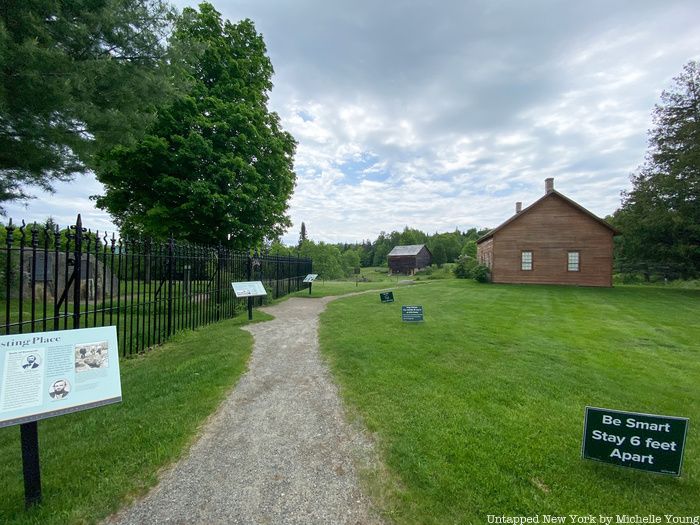
The passing of the 1850 U.S. Fugitive Slave Act, which required free states to assist in the capture of escaped slaves and punished those who helped, spurred Brown into more violent action. The Brown family left the North Elba farm for four years between 1851 and 1855 to return to Ohio to deal with deal with the business they had been running there, and shortly following his return to New York, Brown left for Kansas to assist his sons in the fight against slavery there. His wife and family “struggled to maintain their Adirondack farm during Brown’s frequent absences,” states a sign at the historic site.
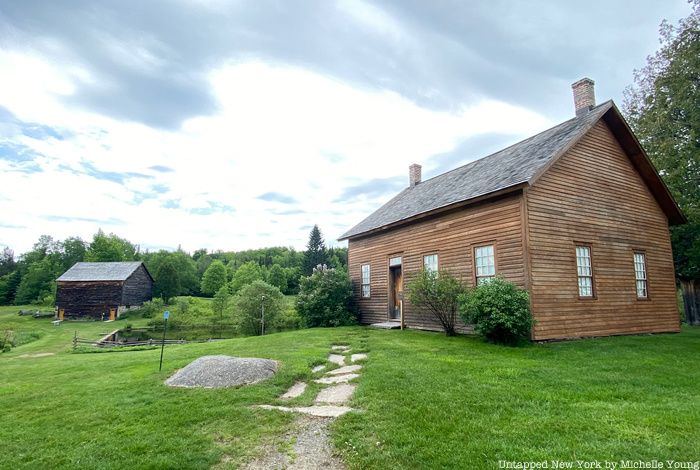
On October 16, 1859, Brown led the attack on Harper’s Ferry, with assistance from Harriett Tubman. It was a plan that was a year in the making, and according to information at the historic site, Brown’s “goal was to destroy the arsenal as a political statement and to weaken government forces. He used the engine house as his fort during the raid and held hostages there until he and his army were defeated by then Colonel Robert E. Lee. Ten of Brown’s men were killed, including two of his sons, seven were captured, and five escaped. Although the raid failed, Brown’s trial and execution fueled the abolitionist movement and stirred national unrest.” A popular song sang by Union soldiers during the Civil War was called “John Brown’s Body” which included the lyrics “Old John Brown’s body lies moldering in the grave, While weep the sons of bondage whom he ventured all to save; But tho he lost his life while struggling for the slave, His soul is marching on.”
Brown was tried in Virginia and found guilty on all counts: murder of five people (specified as four whites and one black), conspiracy with slaves to rebel, and treason against the State of Virginia. Victor Hugo attempted to intervene on his behalf, writing a letter from France that was published in Europe and in America asking for Brown to be pardoned. In it, Hugo foreshadowed the coming Civil War. In part, he wrote “Politically speaking, the murder of John Brown would be an uncorrectable sin. It would create in the Union a latent fissure that would in the long run dislocate it. Brown’s agony might perhaps consolidate slavery in Virginia, but it would certainly shake the whole American democracy. You save your shame, but you kill your glory.” Amongst those present at Brown’s execution were John Wilkes Booth, who would assassinate Abraham Lincoln and Stonewall Jackson, the future general for the Confederacy who was assigned as security.
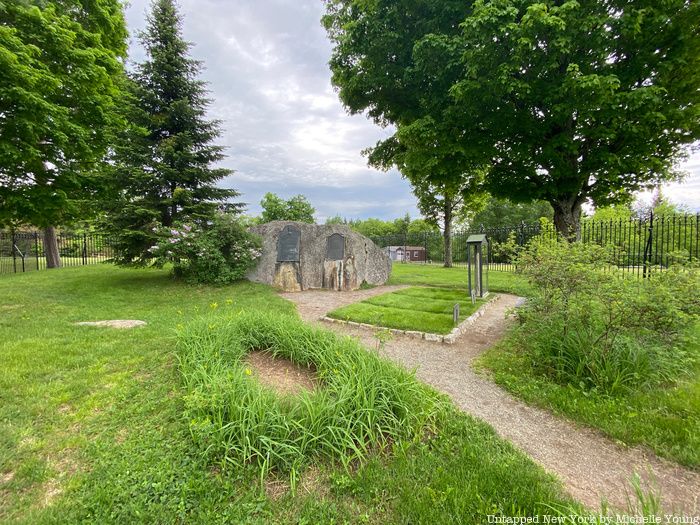
The burial ground at the John Brown Farm State Historic Site is believed to contain twelve men. Shortly after the execution, John Brown’s body was put in a wooden casket with a noose still around his neck and sent to North Elba where he was buried on December 8th, six days after he was hung. Due to a planned attack on the casket by Southern-sympathizing medical students studying in Philadelphia (where Brown’s body was supposed to be embalmed), a decoy train and casket was employed by the mayor of the city. Apparently the sneaky maneuver led to a mass exodus of these students who returned to the South and would join the Confederate army.
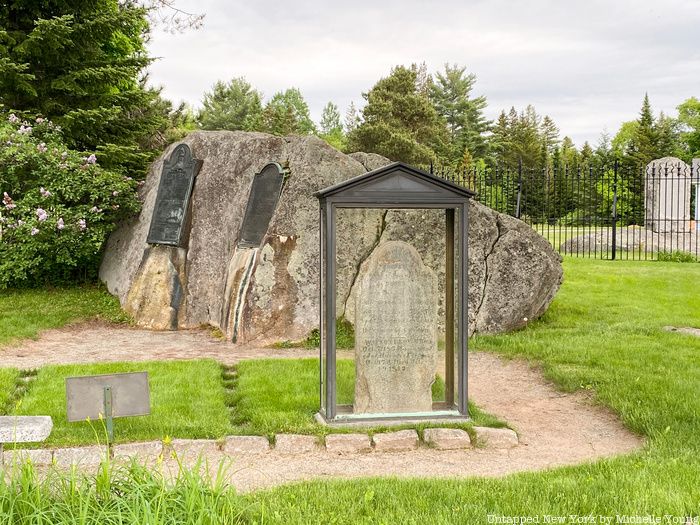
John Brown is buried under the oldest tombstone that is now encased in glass. It was originally a memorial to Brown’s grandfather Captain John Brown who was killed during the Revolutionary War fighting for the Continental Army in Manhattan. On the day Brown was executed, he asked for three names to be added to the stone – his own, the two sons killed at Harper’s Ferry. The stone already had the name of Brown’s son Frederick, who had been killed in their abolitionist activity in Kansas.
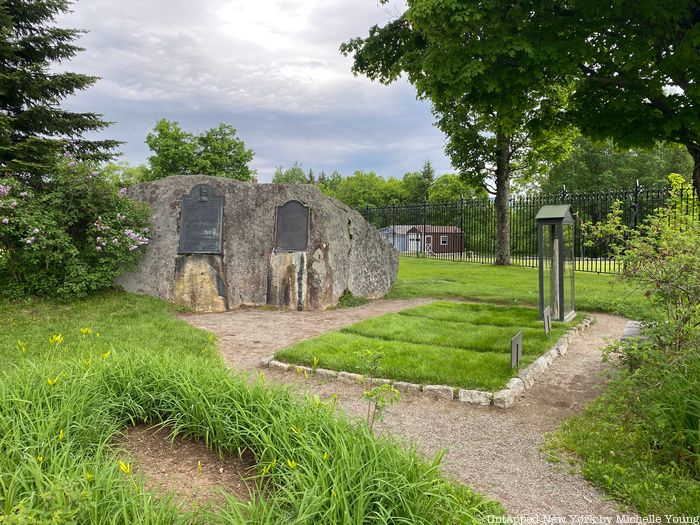
It would take decades for the other men to make their way to this final burial spot. Originally, John Brown’s son Oliver, and seven other of Brown’s men were buried in an unmarked site near Harper’s Ferry. The body of another son, Watson Brown, was used for study in a Winchester, Virginia medical school. When Dr. J.J. Johnson, a regimental surgeon became in charge of the school in 1862, he sent the body to Martinsville, Indiana. Johnson saved Brown’s skeleton and in 1882, according to the state historic site, “when Dr. Johnson learned that the Browns were visiting Chicago, he arranged John Brown Jr. to identify Watson’s body. After their meeting, Johnson sent the body to North Elba along with identifying documentation. The family buried the remains at the farm the same year.” Afterwards, a search for the other Harper’s Ferry men began led by Captain E.P. Hull, Dr. Thomas R. Featherstonhaugh, and Professor O.G. Libby. Libby sent the bodies of eight men to North Elba in 1899, and the researchers also exhumed the bodies of Albert Hazlett and Aaron D. Stevens in New Jersey and relocated them to North Elba.
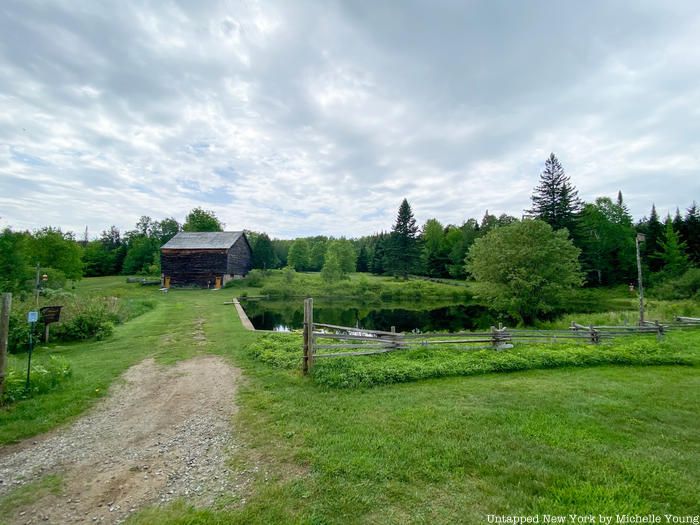
By the time the other bodies were sent to North Elba, the Brown family had moved to California and the farm was purchased by a relative. The farm was then bought by the John Brown Memorial Association, led by journalist Kate Field who enlisted help from the Union League Club. The association then donated the site to New York State where it was used as a farm through the 20th century. In the 1950s, the farmhouse was restored to a mid-19th century state and furnished inside, to represent what it might have been like during the Brown’s tenure here. The original barn still stands but was moved in the 1920s, when the pond was also created for fire fighting purposes. A statue of John Brown, commissioned by the John Brown Memorial Association in 1935, can be found in the entrance circle to the site .
At this time, due to COVID-19, the John Brown Farm State Historic Site grounds are open but you cannot currently enter the building. Historic signs help guide your visit and there are QR codes to provide additional audio information.
Next, check out 9 abandoned sites in New York State’s Lake George region.
Subscribe to our newsletter